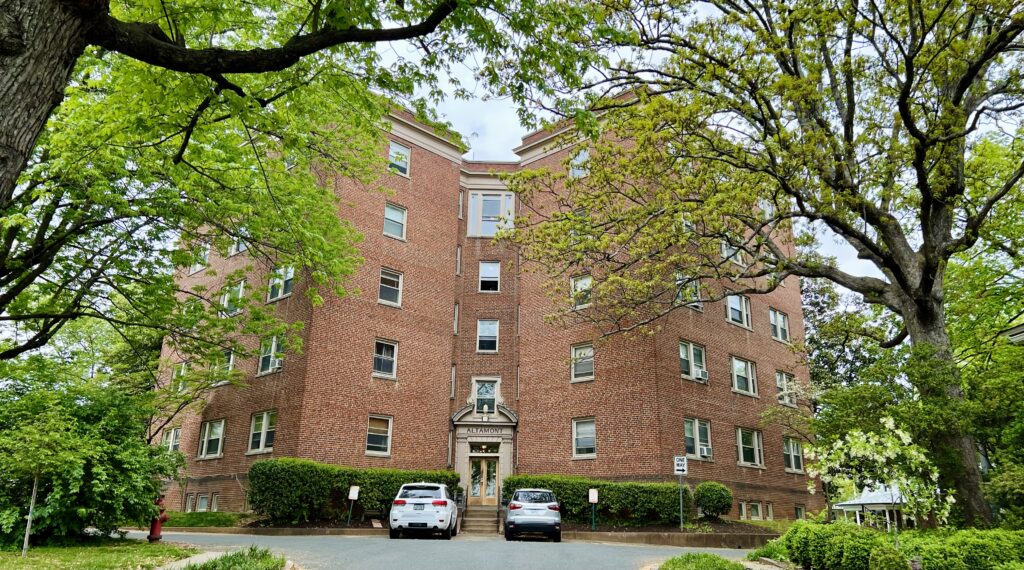A single-staircase structure in Charlottesville built before modern codes. (Lyle Solla-Yates)
Virginia’s next building code update isn’t until 2027, but state lawmakers are already proactively thinking about ways it could be tweaked to help foster development on vacant or underutilized urban parcels and encourage affordable housing. An advisory group is expected to produce recommendations for how Virginia might update its zoning code to allow for certain multi-unit buildings over three-stories to only need one stairwell instead of several.
The idea is that in lieu of an extra stairwell, buildings on smaller parcels in urban areas can still be developed or redeveloped to create additional housing units.
“When you go from three to six floors, you open up a lot more options for units,” said Sen. Schuyler VanValkenburg, D-Henrico, who carried a bill to create the advisory group in this year’s legislative session. “It’s not a cure-all, but it does allow you to redevelop and increase your units.”
The advisory group is weighing the pros and cons of doing so and preparing recommendations to share by the end of this year. His bill, also carried by Del. Adele McClure, D-Arlington, passed the legislature with bipartisan support before being signed by Gov. Glenn Youngkin.
“We’re seeing an increased momentum across the country, both at the state level and the locality level, because of, to be quite frank, the housing crunch, the supply crunch, the affordability crunch,” VanValkenburg said.
He points to localities that have allowed for single-staircases for buildings up to six floors — like Seattle, Washington, New York, New York and Honolulu, Hawaii. These types of structures require considering factors like caps on square footage or number of residential units per floor or specific additional fire safety measures. At the state level, Tennessee passed a law this year to allow localities to adopt building code sections for single-stairwell residential buildings up to six stories.
While the concept could help with housing and infill development, public safety officials do note fire hazard concerns. Steven Sites, a fire marshal in Fairfax who serves on the advisory group, noted potential issues in single-stair buildings over three floors.
For instance, he said that not all fire vehicles have the equipment to reach higher windows and he noted how both firefighters and residents would utilize the same stairwell when residents are trying to evacuate as firefighters respond to a fire.
He said that if Virginia were to pursue allowing for single-stair buildings up to six floors, there could be things to “make this have a better look and feel for fire service.”
That could entail requiring smoke detectors in the common areas.
“Currently in the code in an apartment-style building like this, there’s no requirement for smoke detection in these common areas,” he said. “So we know that’s a piece that could be added.”
He added that another consideration could be if certain localities should be allowed to tap into single-stair code or if it would become a statewide requirement for buildings up to six floors.
VanValkenburg said that he and McClure didn’t want to “legislate building codes.” He said that they saw their measure to create an advisory group as a way to encourage adoption of single-staircase allowances when Virginia updates its zoning code in 2027.
The report from the advisory committee will be one part of the larger process when Virginia next updates its building code.
Andrew Clark, vice president of government affairs for the Home Builders Association of Virginia, previously told The Mercury how tweaking staircase requirements can help solve development issues in spaces that are ripe for housing but would otherwise be abandoned projects.
“This has the potential to unlock some really challenging sites in cities and built out areas that are trying to figure out how to do infill right,” Clark said. “Removing one staircase can really change the equation on what housing can be provided more affordably. Once you start opening up square footage from the staircases and corridors that eat up so much space, you can create more of a communal feel for new buildings.”
As the advisory group works on recommendations, it will still be some time before the state could consider adopting any of them. But VanValkenburg and McClure’s bill was part of a handful of housing-related bills to pass the legislature this year aimed at addressing growing housing affordability issues in Virginia.
“It’s zoning, it’s the building code, it’s money in the affordable housing trust fund — it’s a bunch of different things,” VanValkenburg said of the various efforts it will take from various people and entities to help with Virginia’s affordable housing issues. “But this is a pretty low-hanging fruit policy idea, I think.”
YOU MAKE OUR WORK POSSIBLE.

